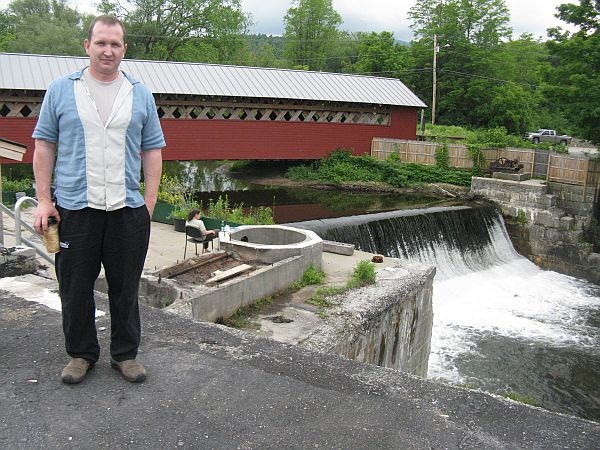
(Host) Many of Vermont’s villages and towns were built around water power, and many of the small dams that produced that power still exist. But despite the current demand for renewable energy, few of the old dams have been revived.
Critics have blamed the state Agency of Natural Resources for the holdup. Officials say that’s beginning to change.
VPR’s Susan Keese has more.
(Sound of dam rushing)
(Keese) Bill Scully stands on a concrete deck that once housed the turbines that ran the Bennington Tissue mill beginning in the 1880s.
A few feet away, under a red covered bridge, the Walloomsac River roars over an 85-foot spillway.
(Scully) "This’ll make in excess of one million kilowatt hours a year."
(Keese) Scully, who owns several local businesses, bought the paper plant in 2009, after fuel reached $4.50 a gallon.
(Scully) "I had this little epiphany that we live in a mill town. There’s energy all around us and nobody’s using it. So I really went after trying to find a dam that was suitable for redevelopment."
(Keese) Scully was surprised to learn that Vermont hadn’t approved a new hydroelectric project in decades.
The Agency of Natural Resources didn’t even have an application for the permit required by the federal agency that licenses hydro dams.
(Scully) "Vermont is known for being very anti-hydro."
(Keese) But Brian Fitzgerald of the ANR’s Department of Environmental Conservation says that’s not so.
(Fitzgerald) "There has been this popular perception that it’s almost impossible to get a project certified in the state, and, the record we’re developing now shows that’s just not true."
(Keese) Fitzgerald says there’s been little interest in developing hydro since federal incentives dried up at the end of the 1980s. It’s only been a few years since interest has revived. He says now, new incentives are once again making marginal projects feasible.
(Fitzgerald) "There are several projects in various stages of the process now. And as we gain more experience and develop a track record, we’re looking at areas where we can make improvements."
(Keese) Last year at the legislature’s request the department developed a procedure for applicants to follow. Fitzgerald says he knows not everyone is satisfied.
But he adds that of the half dozen applications now in the pipeline, one very small homestead project has been certified. Another two, proposed for existing flood control dams in Jamaica and Townshend – have won preliminary approval and are scheduled for a public hearing.
In Bennington, Bill Scully says his project is moving along better than he expected. He received a letter from the ANR in May calling for $100,000 worth of impact studies – enough to make his project economically unrealistic.
(Scully) "Spending that kind of money in the early stages, you’re really taking a leap of faith. Who knows if you’re even going to get a license in the end?"
(Keese) But a recent meeting with state officials led to design changes that Scully says are better for the waterway and reduce the need for tests. He says he came away encouraged by the spirit of collaboration from the agencies involved.
For VPR News, I’m Susan Keese in Manchester.
Visit the Series Homepage